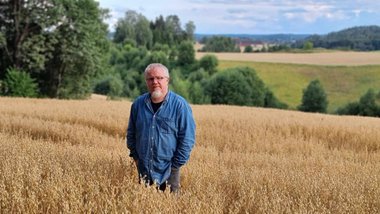The History and Present of the Basilian Monastery in Dobromyl

RISU’s Ukrainian-language site posted the text on 3 May 2007.
The history of the monastery of the Basilian fathers in the city of Dobromyl, Staryi Sambir District, in western Ukraine’s Lviv Region, is a good illustration of church life in Halychyna (far western Ukraine) from historical times to the present. In her article, Tetiana SHPAIKHER tries to illuminate the glorious pages of its history and also accent today’s problems.
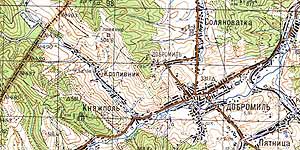 We will start with a short history of Dobromyl. This is a typical town of Halychyna located not far from Przemysl, Poland, on the very western edge of present-day Ukraine, near the border. Its roots reach back to the times of the Duchy of Peremyshl (Przemysl). The first written reference to Dobromyl dates to 1374, when the master of Halychyna, Wladyslaw Opolski, gave the lands of Dobromyl to the Herburt family. The city knew its greatest development in the 17th century, during the life of Jan Szczesni Herburt, a noted sociopolitical activist. Disillusioned with big politics, Jan threw away his diplomatic career and returned to Dobromyl. Here he opened a printing house, and was involved in educational activities and the building of the city. In 1612 he and his wife Elzbieta gave the land for the building of the monastery.
We will start with a short history of Dobromyl. This is a typical town of Halychyna located not far from Przemysl, Poland, on the very western edge of present-day Ukraine, near the border. Its roots reach back to the times of the Duchy of Peremyshl (Przemysl). The first written reference to Dobromyl dates to 1374, when the master of Halychyna, Wladyslaw Opolski, gave the lands of Dobromyl to the Herburt family. The city knew its greatest development in the 17th century, during the life of Jan Szczesni Herburt, a noted sociopolitical activist. Disillusioned with big politics, Jan threw away his diplomatic career and returned to Dobromyl. Here he opened a printing house, and was involved in educational activities and the building of the city. In 1612 he and his wife Elzbieta gave the land for the building of the monastery.
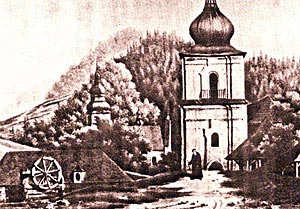 Today it is unknown from where the first monks came that settled here. According to one version they came from Lviv, according to another, from Transcarpathia. Perhaps every new owner of the town gave land to the monastery, which made it very rich. There were two wooden churches at the monastery: St. Nicholas and St. Elijah. Bad weather ruined the first and the monks took it apart. They sold the Church of St. Elijah to one of the villages in 1772 after the construction was completed on the walled church of St. Onuphrius. The monastery developed at a fast pace and started to establish daughter monasteries.
Today it is unknown from where the first monks came that settled here. According to one version they came from Lviv, according to another, from Transcarpathia. Perhaps every new owner of the town gave land to the monastery, which made it very rich. There were two wooden churches at the monastery: St. Nicholas and St. Elijah. Bad weather ruined the first and the monks took it apart. They sold the Church of St. Elijah to one of the villages in 1772 after the construction was completed on the walled church of St. Onuphrius. The monastery developed at a fast pace and started to establish daughter monasteries.
Starting in 1693 until 1902 with a small break there was a novitiate of the Order of St. Basil the Great in Dobromyl. In the second half of the 18th century for some time here theology studies were conducted. In the 19th century because of sociopolitical circumstances the Basilian order found itself in a crisis and the Dobromyl monastery started to decline. As a way out of the situation, the reform of the Basilian novitiate was proposed, giving the monastery for some time to the Jesuits. In 1882, the Jesuits conducted the famous Dobromyl reform which had significant influence on the further development of the order. At that time and also today they interpret this in different ways. Some consider it yet another attempt at Latinization, others a good way out of a crisis. In 1883, Metropolitan Andrey Sheptytsky, head of the Ukrainian Greek Catholic Church (UGCC) from 1901 to 1944, began his monastic life here. After he finished his novitiate he was the novice master until 1889.
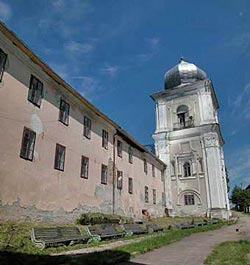 One of the fruits of reform was the start of devotions to the Sacred Heart of Jesus, which in time spread through the whole world. Because of the unsatisfactory condition of the monastery premises, the Jesuits in Dobromyl did not stay there long. The novitiate was transferred to the Krekhiv monastery, where it is today. Under the Soviet regime, the monastery building was used as a psycho-neurological treatment center for women. This caused great damage to the sacred art of the monastery. The Basilians returned only in 1992. From this time the monastery church was rebuilt and rebuilding of the Chapel of the Sacred Heart of Jesus is being completed. The superior of the monastery is performing renovation mainly thanks to the donations of local faithful. Because there is not sufficient funding, neither the monastic cells nor the monastery’s 17th-century bell tower have been repaired.
One of the fruits of reform was the start of devotions to the Sacred Heart of Jesus, which in time spread through the whole world. Because of the unsatisfactory condition of the monastery premises, the Jesuits in Dobromyl did not stay there long. The novitiate was transferred to the Krekhiv monastery, where it is today. Under the Soviet regime, the monastery building was used as a psycho-neurological treatment center for women. This caused great damage to the sacred art of the monastery. The Basilians returned only in 1992. From this time the monastery church was rebuilt and rebuilding of the Chapel of the Sacred Heart of Jesus is being completed. The superior of the monastery is performing renovation mainly thanks to the donations of local faithful. Because there is not sufficient funding, neither the monastic cells nor the monastery’s 17th-century bell tower have been repaired.
Every Sunday faithful from Dobromyl and neighboring villages come to the monastery for Liturgy. Inasmuch as the monastery is located outside the city on a “holy hill,” for many the Sunday trip for Liturgy has the character of a pilgrimage. Twice a year pilgrimages which have been given special religious indulgences are held at the monastery, for which hundreds of faithful from Dobromyl and beyond come.
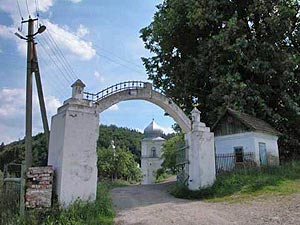 To speak about the monastery’s future, the main problem is the absence of funding for its repair. Any changes are possible only after repair. In the past the monastery played an important role for the Basilian order, inasmuch as here the formation of young monks went on. Today, when the Dobromyl cells still need serious repair, the novitiate for a long time now has been located in the rebuilt Krekhiv monastery.
To speak about the monastery’s future, the main problem is the absence of funding for its repair. Any changes are possible only after repair. In the past the monastery played an important role for the Basilian order, inasmuch as here the formation of young monks went on. Today, when the Dobromyl cells still need serious repair, the novitiate for a long time now has been located in the rebuilt Krekhiv monastery.
To speak about prospects for an indulgenced pilgrimage center, today the monastery has indulgenced pilgrimages, but they have rather a local character. Regarding a church-wide scale, there is a question if such a need exists now. The UGCC already has indulgenced pilgrimage centers and of course they are all located in western Ukraine. Still, Dobromyl, because it is close to the Polish border, could play an important role in the contact of the UGCC in Poland with the Greek Catholics of Ukraine. For an annual indulgenced pilgrimage to the monastery great numbers of clergy and faithful of the Przemysl Metropolitanate of the UGCC would travel in. In time, the Greek Catholics of Ukraine would revive the pilgrimage to Kalwaria Paclawska which is now located on the territory of Poland. Such events will have a positive influence on strengthening the internal unity of the UGCC, which exists not only in Ukraine.
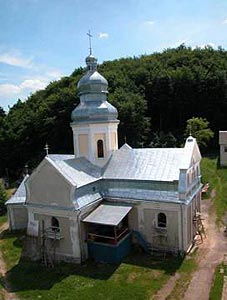 Another prospect is the rebuilding of the monastery as a retreat center for youth, a place for conducting evangelization meetings (sarepta) and youth camps. Fr. Makarii Fliachok, superior of the monastery, expressed this idea. The monastery would be wonderfully suited for such goals, inasmuch as it is located a little distance from the city, it has enough land for further construction, and is located in beautiful natural surroundings. Dobromyl is also interesting for its historical memorials, including the ruins of the medieval castle of the Herburts, the 17th-century bell tower, the 18th-century Roman Catholic Church of the Lord’s Transfiguration, Holy Spirit Church, and the salt mines of Salina from the 12th century, in which the Communist authorities in the 20th century tortured to death more than 3000 people. To realize this idea, and the two previous ones, good financial resources are needed, and for now they are lacking.
Another prospect is the rebuilding of the monastery as a retreat center for youth, a place for conducting evangelization meetings (sarepta) and youth camps. Fr. Makarii Fliachok, superior of the monastery, expressed this idea. The monastery would be wonderfully suited for such goals, inasmuch as it is located a little distance from the city, it has enough land for further construction, and is located in beautiful natural surroundings. Dobromyl is also interesting for its historical memorials, including the ruins of the medieval castle of the Herburts, the 17th-century bell tower, the 18th-century Roman Catholic Church of the Lord’s Transfiguration, Holy Spirit Church, and the salt mines of Salina from the 12th century, in which the Communist authorities in the 20th century tortured to death more than 3000 people. To realize this idea, and the two previous ones, good financial resources are needed, and for now they are lacking.
 Here is a short interview with the superior of the Dobromyl monastery, Fr. Makarii Fliachok.
Here is a short interview with the superior of the Dobromyl monastery, Fr. Makarii Fliachok.
–Fr. Makarii, please tell us how long you have served at this monastery and what changes it has seen since then?
– I came here in May 2000 at the assignment of Basilian Fr. Yosyf Budai. I worked on the damaged church, in which my predecessor, Fr. Nykodym Huraliuk, began the repair. He was able to fortify the walls of the central dome. I was able to finish this construction, roof the church, and repair it inside. We also began rebuilding the monastic cells in which the Soviet authorities had put a psycho-neurological treatment center for women.
This year we began rebuilding the monastery’s Chapel of the Sacred Heart of Jesus. Fr. Meletii Lonchyna started this devotion and it spread through the whole world. In the monastery garden there had been a small chapel which was ruined at some time. Fr. Volodymyr, who is here with me, asked old-time residents about its exact location. This year we started rebuilding this chapel, and in June 2007 we plan to celebrate molebens [prayer service] in it. (The month of June is traditionally dedicated to the Sacred Heart of Jesus.)
–The rebuilding of the monastery started with the monastery church itself because of the needs of the faithful. Are you working together with other priests in this area?
–Yes. Our monasteries have long been missionary centers where people came on pilgrimage from various parishes. Priests also came here. Sometimes certain misunderstandings happened between the monastery and the parish. Until recently many people came, and, so that they had a place to pray, we had to rebuild the church. But now all these misunderstandings are behind us and we work together closely with Fr. Viktor Kotsymira, pastor and dean of Dobromyl.
– How often does the monastery have visitors?
–Sometimes tourists come from nearby Poland or the families of monks that once lived here. Sometimes those come who are studying monasteries and interested in their history. There are even students writing diploma works about our monastery.
–Please tell us what the monastery still has that recalls its past.
–The only memorials are the monastery walls and the cemetery of the monks. We have cleaned up around all the graves, but we don’t know who is buried where. We could only make out the grave of Fr. Meletii Lonchyna, on whose tombstone the initials were preserved.
–How do you plan to use the monastery in the future?
–We want to make a retreat complex for young Christian organizations. There is a good amount of land here and nice natural surroundings. This is a good motivation for building, but the monastery also has historical value. Many noted figures came from here. Metropolitan Andrey Sheptytsky began his spiritual path here. At first he went through the novitiate, then he was novice master. Finally, from our monastery the well-known Dobromyl reform of the Basilian order started.









